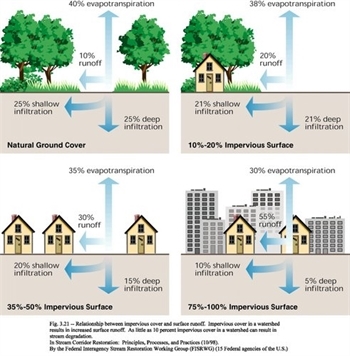Teenagers and rain have a lot in common. When they have nowhere to go, they cause trouble.
It's been a few weeks since it stopped raining, but boy did it rain, and rain, and rain. In late July, we got more than seven inches of rain— what the Chicago region sees in two months during a normal summer — in 24 hours. The following weekend, just when things were starting to dry out, another major storm hit, dropping as much as five inches in five hours in Joliet.
Unfortunately, a lot of that water had nowhere to go. Falling on streets, roofs, parking lots, and other impervious surfaces, all that rain had no chance to soak into the ground, but instead ran off into the sewer. Once the sewer was full, the water couldn't go down the drain, and voilà, flooding.

As the amount of impervious surface increases, so does the amount of runoff.
Chicago Metropolitan Agency for Planning
All that rain, which is really quite clean, gets mixed with raw sewage, and if we're lucky, goes through the wastewater treatment system. If there's too much, the system backs up and we have combined sewer overflows. Wastewater utilities are forced to release untreated sewage back into our waterways. The more pavement you have, the more likely you are to have problems. The Chicago Metropolitan Agency for Planning's Stormwater Management Strategy Report explains all this in great, but accessible, detail.
The July and August storms were huge events — somewhere in the vicinity of 60 billion gallons of water fell during the July storm, equal to about ten percent of the region's annual water consumption. Between July 23 and August 9, the Metropolitan Water Reclamation District recorded combined sewer overflows on 12 different days. On the night of July 24, the situation got so bad that the locks into Lake Michigan had to be opened, releasing 6.5 billion gallons of untreated sewage and stormwater back into the lake. Equally alarming, the entire 109 miles of the Deep Tunnel system filled up.
Even in smaller storms, the fact that so much rain — the only water that is truly delivered free of charge to our homes — runs off into the sewers is a major problem. We pay to treat and dispose of all that water, even though it's more or less clean. Instead of replenishing our water supplies with it, we basically flush it down the toilet.
The other issue is the intensity of the storm. Several inches of rain over a couple days is one thing, but five inches in five hours is something altogether different. The system just can't handle that kind of volume that quickly. That's where the bad news comes in; most climate change projections for the Chicago region suggest that the future holds more intense storms like the ones we just had.
The good news is that there are many, many ways to reduce the runoff that overwhelms our sewers. Moreover, with the these storms fresh on people's minds, we may also have momentum on our side. So...
- It's time to get serious about green infrastructure. Permeable paving, rain gardens, and green roofs capture rain and either hold until the weather dries out or slow its progress toward streams or sewers. The Ill. Environmental Protection Agency and the University of Illinois recently submitted a green infrastructure plan to Governor Pat Quinn and the General Assembly, recommending changes to the criteria the state use for allocating water infrastructure loan funds, as well as the creation of fees for stormwater management...
- ... which brings us to the money. Right now, most people in Illinois pay for stormwater management (if they pay for it) through their sewer bill or property taxes. The latter is particularly problematic. If you invested in green infrastructure, your property values would likely increase, even as your stormwater runoff decreased. You'd be paying more for contributing less. Hardly an incentive for existing property owners to invest runoff reduction permeable paving. There are better ways. Stormwater utility or impervious surface fees are transparent, prompting people to think before they act and encouraging retrofits to existing properties. The City of Rolling Meadows charges $1.65 for every 3,604 sq. ft. of impervious surface per month, giving both existing and prospective property owners reason to stop and think about how much runoff they want to be responsible for. It's a fee, not a tax, so if you reduce your impervious surface, you pay less.
- We need to get smart, and innovative, with rain barrels and other rainwater storage. In small storms, rain barrels are great (you can get a good deal on one right now from MWRD). Catch the water, keep it out of the sewer, use it later. In larger storms, they sometimes fail to live up to their potential because they fill up at the wrong time—namely, at the beginning of the storm when the sewer has excess capacity. Ideally they'd fill up later when the sewers are in most danger from overflowing. Either way, they're a good thing to invest in, and rain barrel rebates, giveaways, and education sessions are a fairly simple way for local governments to get property owners thinking about their role in decentralized stormwater management. Of course, having one and using it correctly are two different things, so study up.
- Even better, let's use all that rain for something. Yes, you can capture it and use it later to water your garden. Or, if SB2549 passes in the fall veto session, you could harvest it, store it in a cistern, and use it to flush your toilet, wash your car, or any number of non-potable uses. There's really no good reason to flush some of the world's highest quality potable water down the toilet. Unfortunately, rainwater harvesting is currently taboo in Illinois, but only because there are no standards for the technology in the state's plumbing code. It's time to change to that, and we're working on it. MPC and our partners could use your support. Contact me to get involved.
Above all else, education is crucial. In September, MPC and Openlands, with the support of Illinois American Water, will launch "What Our Water's Worth," a long-term awareness campaign about the value of water and the services needed to provide it. Keep an eye out for that, but also encourage other outlets to do their part. When newscasters tell you rain is on its way, they should also tell you to save your laundry for another day (keeps water out of the sewer), turn off the sprinkler system (it's just dumb and obnoxious to have your sprinkler on while it's raining), and empty your rain barrel

A rendering of Aurora's new police station, which includes permeable paving throughout the complex.
Leopardo Companies, Inc.
(to give you some storage capacity). Communities need to lead by example, and some are. Aurora's new police station manages some stormwater on site, and the new 41st Street Beach pavilion in Chicago harvests rainwater. Libraries, schools and municipal offices are the perfect places for highly visible pilot projects, but then communities need to talk with property owners about on-site stormwater management, provide education, and ultimately reward property owners that do their part.
Rain falls where and when it wants. It's a decentralized phenomenon. Our response needs to be coordinated, but decentralized too. That means managing as much stormwater as possible where it falls, not just channeling it away somewhere in a pipe. Our larger infrastructure systems should kick in for the big storms, but for a few inches? That we can handle differently, but it will a require a fundamental shift in our societal and engineering mindsets. There's no time like the present to start, after all, the Weather Channel is predicting thunderstorms tomorrow night.